#Assisted Living Livermore
Explore tagged Tumblr posts
Note
Operation Ivy is a ska punk band born out of Berkeley, California in 1987 by Tim Armstrong and Matt Freeman, who later went on to form Rancid. The band existed for two years until they broke up, and in that time released one EP called Hectic, and one full length LP called Energy. Energy has since been remastered and can be listened to on Spotify and Apple Music, but I'm not sure if you can find Hectic anywhere. If you can, then it'll be sold for a shit ton of money by a collector somewhere.
Armstrong and Freeman had played together for a few years prior to forming the band. Armstrong (who, by the way, has no relation to Green Day's Billie Joe Armstrong) recruited Jesse Michaels from North Berkeley to play with them, then soon after added Dave Mello to the lineup. Armstrong was guitar, Freeman bass, Michaels lead singer, and Mello drums.
The name "Operation Ivy" came from two thermonuclear bomb tests staged by the US government in the 1950s. It was around then, at the band's inception, that Tim Armstrong took his first stage name, Lint. Later he'd go by Tim Armstrong, and Tim Timebomb.
Their first show was at Mello's house, and their second at 924 Gilman Street. They played often there, and their second-to-last concert was also held there. Their first show there was as a supporting act for the band MDC, and they quickly became very popular at Gilman despite not being very well known outside of the Bay Area.
In 1988, they toured the US. They lacked a van (the idiots) and so traveled in a 1969 Chrysler Newport. They'd later estimate they traveled three thousand miles in the car, but Lawrence Livermore claimed they drove at least twice that. They spent six weeks on the road, sleeping where they could and sometimes being forced to sleep in the car if they couldn't find another place. The tour brought very mixed shows; some with only a few people, some full of fans.
Upon returning to the East Bay, they found their popularity had skyrocketed. A concert held at Gilman to welcome them back drew the largest crowd in Gilman's history. Livermore suggested they record a second EP after seeing the success of Hectic. The band disagreed, saying it was time to record a full album.
The recording time spanned from the winter of '88 into the spring of the next year. The band had wanted to record at an empty Gilman because,,, honestly why the fuck not? It's Gilman, it's an insanely important part of punk history. Radely Hirsch, the technician who'd manned Gilman's sound desk for a long ass time, was rather diagreeable with how the songs should be played. He wanted a cleaner sound on the bass, while Freeman wanted a different sound with a different amp. It took weeks to record a single song, because the band wanted to capture the same feeling that playing a show to a live audience at Gilman had.
So. They packed up their shit and moved to recording at the Sound and Vision recording studio in San Francisco. Producer Kevin Army assisted in the production, and the band quickly turned from frankly rather shit to one of the most famous bands of the late 1980s. In only a week, all nineteen songs on Energy had been tracked; the band members refused to stop for even food.
But as always, shit happens. The band was beginning to fracture a bit, with Armstrong turning to alcohol and getting drunk all the time. After a massive chewing-out by Livermore after an especially poor performance, he cut it out. But by then, other shit had begun to change. Gilman ended up closing down for a while due to loss of funds, but did end up reopening a bit later on.
May 28, 1989 was the band's last performance at Gilman. The show was both a concert and in support of Energy, and Op Ivy only played once more after that; at a party the following afternoon.
Rancid's A Journey To The End Of The East Bay is about Op Ivy and is both a love letter to the band and it's many fans, and a story of band with lyrics such as, "Started in '87, ended in '89/Got a garage or an amp we'll play any time."
stop because this was genuinely interesting
12 notes
·
View notes
Text
Sometimes On The Road Of Life
Has it become more and more difficult for your loved one to live alone, without a form of assistance? Bethany Home is here to help!
Sometimes on the road of life, people get to a place where they are no longer able to live on their own. For over 20 years, Bethany Home has been helping seniors that are no longer able to live by themselves through providing high-quality assisted living services in Alameda and Contra Costa Counties.
With experience in caring for own elderly loved ones, such as our parents and grandparents, we here at Bethany understand the difficulty in finding the right care for your aging family member. Our home-like environment provides a smooth transition from individual living to intuitive assisted living and care.
Let us worry about your loved one's day-to-day needs so you can focus on spending quality time together, building lasting memories!
Founder (Elizabeth)
Elizabeth founded Bethany Home in 1993 when she began caring for her aging father and mother-in-law. We know firsthand the joys and challenges of caring for a family member, as well as how important it is to find peace of mind knowing that your loved one receives loving and qualified care.
Managing Director (Ari)
Being involved in Bethany Home since childhood, Ari grew up around the elderly. He always felt as if he had hundreds of grandparents over the years. He loves developing relationships with a variety of people and brings youth and energy into the day-to-day interactions and operation of the homes with a desire to assist seniors and their families to the best of his ability.
Our Story
Bethany Home started over 20 years ago, when we began caring for our own elderly parents and grandparents. We provide this same loving and familial care to every individual that makes Bethany their home.
We know how difficult it is to choose the right care or assisted-living home, and this is why we do all that we can to make each resident feel as secure and loved as they deserve.
Our Mission
Our mission here at Bethany is Simple:
“We strive to provide the best quality of life and care for each resident in a familiar home-like environment.”
Our Core Principles
• Offer the respect and dignity that all of our residents deserve.
• Provide a love-based approach to serving our residents.
• Create a joyful environment in which the body, mind, and spirit of our residents, visitors, and staff can thrive.
For more details on our products and services, please feel free to visit us at Homes for the elderly concord, ca, Dementia Care Facility Livermore, Assisted Living Facility Livermore, Dementia Care Livermore&Homes for the elderly Livermore
#Homes for the elderly concord ca#Dementia Care Facility Livermore#Assisted Living Facility Livermore#Dementia Care Livermore#Homes for the elderly Livermore
1 note
·
View note
Text
“...Historians concur that live-in domestic service was primarily an urban phenomenon in the late nineteenth century. One estimate suggests that between 15 and 30 percent of northeastern city-dwellers hired live-in domestics. The historian David Katzman, who has generated the most refined statistics, demonstrates that even within relative geographical proximity, city-dwellers hired servants more often than did rural dwellers, and city-dwellers with large pools of foreign labor more than city-dwellers without. Nationwide at midcentury there was one domestic servant for every ten families, with a considerably higher ratio in large cities like Boston and New York.
A greater proportion of Bostonians hired domestic servants than did residents of any other northern city, with 219 servants per thousand families. With traditions of household service born in slavery, even after the Civil War, the South led the nation in its reliance on domestic servants, with Atlanta in 1880 boasting 331 servants per thousand families. Even in the South, though, the difference between city and country was notable, with Atlanta in 1900 hiring four times as many servants per thousand families as in the rest of Georgia. Together these figures suggest the flourishing of an era in the history of Victorianism. It was common for American bourgeois city-dwellers on the Atlantic seaboard, even ones of modest means, to rely on the labor of maids to sustain their households.
Of course, the end of the story is popular cliché. With the opening of more lucrative and less degrading jobs for young women as sales clerks, ‘‘typewriters,’’ and teachers, the ‘‘servant problem’’ became terminal, and by the First World War, American housewives could not depend on the hiring of live-in domestic help to assist them in their housework. It is significant, though, that even when ‘‘necessity’’ suggested the reintegration of daughters into the domestic economy, they were gone for good. The culture had put girls to other uses, from which they would not return to their mothers’ sides.
We still might ask why girls were often excused from domestic labor— especially given the compounding weight of the advice literature recommending otherwise. The answer lies in the increasing role played by daughters and servants in the bourgeois quest for refinement. Even when the gross number of live-in servants declined as production moved out of the home, the hiring of at least one domestic remained a prerequisite for middle-class status. The statistics on who hired servants bear out the middle-classness of this phenomenon, with 65 percent of servants in the Northeast in 1860 working in households with no other servants. In an increasingly mobile and prosperous society, hiring servants was one way to demonstrate standing, a concrete and conspicuous way of demonstrating what you had left behind.
One historian argues that the cultural importance of servants should be measured in the amount that some less prosperous families were willing to spend to hire them—sometimes as much as one-third of family income. Clearly, the freeing of daughters from steady household work and the hiring of domestic servants of lesser, often foreign, status went in tandem with the changing purpose of the home itself. Eighteenth-century households had required helpers to assist in domestic production. The homes of the mid– nineteenth century elite instead featured housework ‘‘as the creation and maintenance of comfort and appearance,’’ in the words of the historian Christine Stansell.
As the Beecher sisters observed, families were increasing ‘‘in refinement’’ such that they no longer wished to live in close intimacy with ‘‘uncultured neighbors,’’ far less daughters of foreign shores, who were working as servants. Thus one mill-owning family in rural Vermont made a point of hiring Irish help rather than the daughters of neighboring farmers, who might object to eating in the kitchen and expect to be ‘‘one of the family.’’ Architects reflected such changes by midcentury, such that servants’ quarters were designed as discrete parts of the house, with back stairs and separate entrances. Custom increasingly favored uniforms and servant dining tables in the kitchen.
At the same time that middle classes aspired to higher standards of comfort and appearance in accordance with new possibilities, women’s primary responsibility shifted from the supervision of a household manufactory to family nurturance, the raising and socializing of children. Much has been written about the evolution of new ideals for motherhood following the American Revolution, as women gained responsibility for raising virtuous citizens. ‘‘Republican mothers’’ shaped new daughters as well as new sons. Initially considered necessary allies in the steady work of processing the stuff of survival, the daughters of middle-class families became themselves the prime products the home produced—the embodiment of the principles of sensibility and refinement.
Mothers’ new responsibilities did not erase old ones. The historian Jeanne Boydston has appropriately criticized the readiness of her colleagues to mistake the ideology of domesticity for reality, arguing that by no means did the productive work of the home cease with the industrial revolution. Instead, Boydston argues, the emphasis on the emotional task of mothering tended to eclipse from view, but not eliminate, the continued real labor—the making of clothing, the putting up of preserves, the carrying of fuel—still carried on in the middle-class home. She is right in her argument that ‘‘paid domestic workers did not free the mistress of the household from labor.’’
But even Boydston acknowledges that domestic servants instead did the work that would have been done by other females in the household—including adult female relatives and daughters. An interesting case in point is the urban family of woman’s rights advocates Henry Blackwell, Lucy Stone, and their daughter Alice Stone Blackwell. As Boydston tells us, Lucy Stone, who was raised on a farm, still kept chickens, worked a garden, and tended a horse and cow, even as she lived a prosperous middle-class existence outside of Boston. Alice Blackwell later remembered that ‘‘she dried all the herbs and put up all the fruits in their season. She made her own yeast, her own bread, her own dried beef, even her own soap.’’
In her lively diary, however, Alice Blackwell reports doing little household work. Such chores as emerge in her diary were designed to interrupt her incessant reading, which was thought to be responsible for her bad headaches. Thus her cousin, visiting the household, ‘‘had undertaken to find me something to stop my reading: churning; and I churned in the cellar till the butter came.’’ In fact, advice writers who had failed in their efforts to promote domestic work for daughters on other grounds often focused on the value of domestic labor as a source of exercise. The Beecher sisters observed that if girls did strenuous housework, their parents would be spared the expense of gymnasiums. ‘‘Does it not seem poor economy to pay servants for letting our muscles grow feeble, and then to pay operators to exercise them for us?’’
Louisa May Alcott, whose collected opus represents a powerful gloss on the domestic debates of late-Victorianism, repeatedly suggested the healthfulness of housework, ‘‘the best sort of gymnastics for girls,’’ according to Dr. Alec in Eight Cousins. Her Old-Fashioned Girl explicitly contrasts the healthy republican daughter skilled in domestic arts with the languid late-Victorian belle, afflicted with boredom because of her lack of home chores. Mothers undoubtedly continued both to supervise and perform much household maintenance, but they did so assisted by domestics rather than their own daughters. What did middle-class girls do instead of housework?
This was a question which greatly concerned commentators, who asked, as did Mary Livermore in 1883, ‘‘What shall we do with our daughters?’’ Mary Virginia Terhune, too, lamented the passing of housework as girls’ raison d’être and with it ‘‘that prime need of a human being—something to do.’’ Parents found a range of things for daughters to do, including the ornamental skills of sewing, playing piano, writing and reading associated with self-culture. Increasingly, also, they sent daughters to school. Common schools designed for both sexes did not include sewing.
In later years, the Beecher sisters observed, ‘‘A girl often can not keep pace with her class, if she gives any time to domestic matters.’’ And they noted, ‘‘Accordingly she is excused from them all during the whole term of her education.’’ Girls themselves noted the increasing power of lessons in any competition with housework. Agnes Hamilton remarked that first her French tutor and then her German homework prevented her from doing her ‘‘share of Monday’s work.’’ It was not long before the work of some girls was reassigned.
Those who were serious about domestic education, such as a composer of ‘‘An Ideal Education of Girls’’ that appeared in an 1886 issue of Education, suggested, in fact, that this disjunction be acknowledged. A girl should receive the same education as a boy until the age of twelve, its author suggested. At that time a girl should drop out of school for two years and learn the complete running of a household, returning to school only with that formal apprenticeship accomplished. Only such complete separation of activities would allow the household its due.”
- Jane H. Hunter, “Daughters’ Lives and the Work of the Middle-Class Home.” in How Young Ladies Became Girls: The Victorian Origins of American Girlhood
3 notes
·
View notes
Photo




SATURDAY MATINEE MUSIC VIDEO: “Oklahoma Hills” This song was written by Jack and Woody Guthrie. Woody initially wrote the song, but Jack (Woody's cousin) changed the lyrics and music slightly and, in 1945, recorded a Western swing version that reached No. 1 on the charts. It remains the best-known version of "Oklahoma Hills", and was the biggest hit of Jack’s short life and career as an aspiring "cowboy star" in Hollywood (he died of leukemia at age 32 at a ranch in Livermore, CA). In 1969, Arlo Guthrie (Woody's son) recorded a catchy version, and the song has gone on to be covered by scores of artists (I do it often when I perform in assisted living homes). My take was recorded live (by Uma Robin Mackey) 4-13-21 at the Hoppy Lockhart rest stop near Sallisaw, OK. It turns out that Hoppy was a local hero who saved lives in road accidents and other catastrophes, so God bless Hoppy and everyone who knew him.
https://www.youtube.com/watch?v=_aYTpJETVcQ
#Oklahoma #JackGuthrie #WoodyGuthrie #HoppyLockhart #cowboysong #westernswing #cowboystar #arloguthrie #Sallisaw #OK #HoppyLockhart #johnnyjblair #singeratlarge
#Oklahoma#Jack Guthrie#Woody Guthrie#Hoppy Lockhart#cowboy song#western swing#cowboy star#Arlo guthrie#Sallisaw#OK#Johnny j blair#singer at large
4 notes
·
View notes
Text
On the rebellions following the murder of Oscar Grant, 01/01/2009 / verdict of not guilty of murder on 07/08/2010
When we realized that, in the eyes of the powerful, our lives are just piles of bones waiting to be shattered, arteries and veins on the verge of tearing open, hearts and lungs that stop beating and expanding at the moment they pull the trigger, the only thing left to do was to come together and make them tremble before us.
Everyone saw the video. At least it seemed that way at the time. A young father's last breaths press against a cold train platform, a cop holsters his firearm and calmly pulls out his handcuffs. Why would they kill an unarmed man with so many people around? Why don't we know how to respond?
I wanted to break windows, to set fires, to strike fear into every cop on the streets that night. I wanted to show the powerful that they, too, would learn the meaning of violence, just as we have been forced to learn it time and time again. They needed to understand that we don't forget, we needed to feel that we were still alive.
Today, the situation is every bit as dismal as it was yesterday. Every hour of our lives spent at work creates the revenue that strengthens the army that confronts us. In Stockton, in Livermore, in Bakersfield; the police continue to open fire on us, we continue to die. We have yet to create a force that can subject them to the misery that will one day confront them, however, we have come closer than we ever thought we would.
Until now, we believed we were fighting battles. On the day of a demonstration, we walked the streets, we fought, and we went home that night, unsure of what to do in the time until the next battle presented itself.
Today, we understand that we are at the beginning of a war. Wars are protracted conflicts. Their results aren't determined at the end of the day. The police have killed again, and, as of today, our response has been less than forceful. In warfare, it is necessary to develop weapons.
We need to learn new tactics. There is still so little we really know how to do. We could learn how to blockade roads or shut down BART trains. With better communication, we could attack police property or raid supplies in places where the cops aren't waiting for us. We are working toward developing the capacity to respond forcefully every time the police kill one of us.
This movement has never had leaders. It is composed of independent and often disconnected groups of people. These groups tend to operate outside of the typical political and social justice networks. So far, their autonomy, their lack of reliance on both the non-profit world and the radical political scenes, has been a strength. We all come from vastly different places, and many people may not be willing to work with one another. Therefore, the point isn't to try to bring everyone together into one organization. What is important is to begin providing supplies to people to assist their ability to continue to struggle autonomously.
...
That night, the night of the verdict, we were reminded how little our lives mean to this system, and that police officers do, in fact, get away with murder.
Demanding justice is not enough. The concept of justice for an individual doesn't address the need to dismantle the system that murdered him. It doesn't prevent any of us from being killed by the police. What is important now is not speaking in terms of justice, but attacking and weakening the institution of policing that continues to wage war against us.
For people who hold the weight of the earth on their shoulders, the fastest way from the bottom to the top is to turn the world upside down, to throw the property of the rich into the street and to dance on the roofs of police cars instead of riding in the back seats.
...
“When the South has trouble with its Negroes – when the Negroes refuse to remain in their ‘place’ – it blames ‘outside agitators’” --- James Baldwin
The term "outside agitator" was popularized during the civil rights struggles of the 1950s, when southern politicians would blame the growing unrest in exploited black communities on the presence of (often white) radicals from outside of the city. Presently, it is a term used by Oakland politicians (and aspiring politicians) to try and keep the situation under control, to prevent local marginalized people from realizing the power they have.
Today, we face enemies that we could have never conceived of before this.
Sometimes, it's the people that pretend to be on your side that are the most dangerous enemies. The non-profit world has, for 18 months, waged a campaign against this movement.
Many non-profits that function independently of the local government have disparaged us. They oppose collective uprisings and spontaneous activity because they feel the need to control the movement. These organizations view themselves as they saviors of the downtrodden; when dominated people rise up on their own terms, it threatens the position of leadership these organizations occupy in their imaginary worlds.
We have also come under attack from non-profits that operate entirely under the influence of the city government. One of these city-funded non-profits has taken up a full fledged assault against us, using some of the $2 million in city money they have received to wage a propaganda campaign against the unity we have found with each other through this struggle. They have even used city money to pay young people to come to their indoctrination workshops where they speak of the evils of people coming together and standing up to their enemies.
They have also helped to spread the absurd logic of the Mayor's Office that only people born and raised in Oakland have the right to take to the streets. This micro-nationalism is an attempt to foster collaboration between disenfranchised people and their exploiters in a unified front against the enigmatic "outsiders."
It is incorrect to assert that non-profits of this type have motivations of their own. They are simply the hip mouthpieces of the city government that funds them. Their agenda is the agenda of the Mayor's Office and the police department. They use the language of "peace" to try to preserve the institutions that created them. We have never been concerned with their peace. The peace of the powerful is the silent war waged against the dispossessed.
In the past, our enemies have attempted to divide movements distinguishing the "good" elements from the "destructive" elements. This time, it seems that the primary division they created was not between the "peaceful" and the "violent" but a racial division wedged between groups in the uncontrollable elements in an attempt to neutralize our collective strength.
35 notes
·
View notes
Text
Roots of Food Insecurity in Alameda Is Connected to Few Factors

In 2021 and 2022, three food banks opened in the Tri-Valley area to address the increasing food insecurity problem. The Alameda County Community Food Bank opened two sites in Livermore in January 2021, and Tri-Valley Haven, another food bank, opened in March 2022. This assistance comes when many people have moved from urban areas in Alameda County to the suburbs.
According to the Alameda County Community Food Bank (ACCFB), food insecurity has always been an issue for residents, one tied to historical factors. In 2022, for a family of four to live in metro Oakland, their household income must equal $92,267 or more, but 65 percent of the people who visit the ACCFB make $28,290, all food insecure.
Food insecurity refers to the estimated number of people with limited access to enough food. The ACCFB report stated that food insecurity in Alameda is connected to racial and socioeconomic impacts. Comparing two maps, one from 1937 and another from 2019, the organization showed factors that were a part of the county’s earlier history impact this century.
More importantly, it found a connection between food insecurity, race, and housing. In general, neighborhoods comprised of residents with high incomes and low rental burdens have lower rates of food insecurity.
The two maps show how systemic policies relegated certain groups to specific areas, and these policies have had residual effects on Alameda County residents in the 21st century. The 1937 Alameda map used a system that graded neighborhoods for homeownership risk based on an A, B, C, and D scale. According to the map, suburban areas received A (Best) and B (Desirable). Conversely, Oakland and surrounding areas received C (Declining) and D (Hazardous).
Twelve percent of the people who lived in Grade A areas were food insecure, and 21 percent of people living in Grade B areas were food insecure. Worse yet, 28 percent of residents in Grade C areas and 32 percent of people in Grade D areas were food insecure. The closer to Oakland a person lived, the more likely they experienced food insecurity.
In 1937, the federal agency Home Owners’ Land Corporation (HOLC) used this map to determine mortgage risk. In assigning grades, the HOLC based most of its assessment on community racial composition. Other factors were area amenities, quality of air, and access to transit.
More importantly, this map determined whether banks lent residents money toward mortgages. As a result, people financing a home in an area with a low grade were less likely to qualify for a mortgage. Alternatively, people financing a home in a high-grade area were likely eligible for federally-backed, low-interest loans.
There was also the issue with redlining, and typically, neighborhoods in the D category were redlined areas. Incidentally, redlining involves banks refusing to finance people who intend to purchase property in certain areas, and historically, it was race-based. Not only was redlining practiced, but it was not uncommon for HOLC maps to contain explicitly-stated racial information to discourage non-whites from purchasing property in those areas.
The 2019 maps reveal that this early history established a narrative that has affected county residents almost a century later. This map shows that food insecurity is still high in places like Oakland, which has a 31 to 59 percent food insecurity rate, depending on where in the city one lives. Additionally, the report states that racial lines that determined neighborhood composition in 1937 are still in place in 2019.
The pandemic has, without a doubt, made Alameda County’s food insecurity problem worse. As of January 2022, 400,000 residents, roughly 25 percent, experience food insecurity. Ultimately, these maps and the report show that hunger and food insecurity in Alameda County is rooted in the above-mentioned historical inequities.
1 note
·
View note
Text
TUESDAY WEEK 9 - ALUMNI GUEST
10:15AM - Alumni Guest Speaker - JAMES TAPSELL-KURURANGI Ropu Groups discussion with James:
Notes:
Speaking about life in the art world - life after study
The idea of the everyday/intangible, very interesting
Martyn Patrick book - Across the Art-Life Divide
Life as Performance Art
Masters -> Bachelor of Design Specialising in Photography -> Masters allowed further potential
Child-hood home became an Air BnB
Framing things as an art work -
Travelling, Taking these trips during Masters
Vital to do masters - The projects are short in undergrad, found that I din’t have enough time to really get into it - coming into Massey an older student - 27, had tried Uni before - Really liked the vibe of Massey.
Was originally interested in Fashion Photography - Questioning commercial photography - was working more around philosophical ideas, wanted more depth in my practice
Assistant Curator at Te Tuhi
Design Skills from Uni still helpful in everyday
Life Experience
How did you get into curating? - Working full time at council at home, break from study, but also to fund life, ended up at a gallery by applying for jobs outside of home, Rotorua, internships etc Trying many things, not getting the position, trying again etc -
Te Huhi studios and parnell project space - did the research and did prep work for this interview!
Trips = the art - how did you validate this as art / how you document it, present the work
“commerce of the domestic home”
feeling of nostalgia - Andrew Jean
Relax into it
existential tone of art school
think about many different processes and things, sound, image etc etc
zines - made many zines freedom writing
just doing things for a bit of fun! not everything has to have pressure
art outside of all formalities
have a go!
Doing some shows, love fashion - fashion show
PAPATUNGA
doing the first show out of uni with some Massey graduates
connections with felow students that studied at Massey
Train - designing face masks to go with show!
making connections through these positions
also making time for own work
I really enjoyed this conversation with James - and how he spoke about his journey in life and art. I did some further research on this curating and found this on the TeTuhi website - Ata koia! a current exhibition curated by James.
“Taking its title from a kīwaha, a saying, that expresses a feeling of wonder or surprise, Ata koia! gives form to what it feels like to be alive today. Featuring newly commissioned and pre-existing mixed-media, sound and moving-image artworks, the exhibition features artists Abigail Aroha Jensen, Brook Konia, Cathy Livermore, Josephine Jelicich, Qianhe ‘AL’ Lin, Qianye Lin, Rachel Shearer, Tira Walsh, Ufuoma Essi and Wukun Wanambi. Asked by curator James Tapsell-Kururangi how they felt about today, the artists responded by contributing artworks that reflect each artist’s lived experience of contemporaneity, variously in dialogue with the shapes and forms of the past, present and future.“ (TeTuhi).

Qianye Lin & Qianhe ‘AL’ Lin 人参果之歌 A Very True Heart, 2022 (installation view) three-channel video 7 mins 16 secs (above).

Abigail Aroha Jensen Inside my Papahou, ngā āhuatanga o te kuku o te tangata e te kēhua, 2022 sound, concrete, iron oxide 4 x 1000 x 400 x 400mm commissioned by Te Tuhi, Tāmaki Makaurau Auckland photo by Sam Hartnett (Above).
Really inspiring and thought provoking in terms of my own future and journey with my art practices.
0 notes
Text
Owning the Customer Experience
Jamie Livermore, CEO of the Atlanta Center for Cosmetic Dentistry, will join us to chat about Owning the Customer Experience from the first phone call. She will share her philosophy and how it has impacted the success of ACCD. And how it has evolved since her involvement in the company. Jamie will discuss how she and her team ensure that every touch has the experience in mind. Jamie will share her approach to training your team (even if you are the team) for both the best and worst situations. Including her proven method for handling upset customers while never wavering from the customer experience.
This discussion-style presentation will allow you insights into how the CEO of a multimillion-dollar business has approached the customer experience throughout the growth stages of the company and how she sees the customer experience evolving as they continue to grow.
What customer experience means in a high-touch business? How to get everyone (employees and contractors) on board with the customer experience? How to maintain the customer experience even when the customer is upset?
Speaker Bio
Jamie has a passion for developing people, her mission is to positively impact their professional life in a way that also enhances their personal life. She started out over 40 years ago as a dental assistant, went on to obtain her dental hygiene license and 20 years ago started her own dental consulting business. She is now honored to hold the position of CEO at ACCD where she has experienced her greatest professional fulfillment. Jamie lives on a cattle farm with her husband, they have two grown sons and three grandchildren.
Event Url:- https://www.ewomennetwork.com/event/owning-the-customer-experience-7742/register
Event Location:-
Maggiano's Little Italy 1601 Cumberland Mall Atlanta GA 30339 United States
Contact Number: 404-488-5258
Here you can see useful links:-
women entrepreneur network plano tx women entrepreneurs network in Vancouver Orlando women entrepreneurs network Women Entrepreneurs Network Miami Women entrepreneur network ottawa Women Networking Events Dallas business women network new york new jersey business women network Business Network events for women women entrepreneurial network
#Women Entrepreneurs Dallas#Women Networking Dallas#women entrepreneur network plano tx#women entrepreneurs network in Vancouver#Women Networking Events Dallas#women entrepreneurial network
0 notes
Text
Jesse Livermore

Jesse Livermore is one of those people whose name, over time, increasingly envelops the veil of mystery. Even Livermore's classic complete biography is a work of fiction. The first attempts to collect actual facts about the trader were made only in the zero years of our century.
Even during his lifetime, Livermore's actions made his contemporaries wonder and find the most fantastic explanations for them, creating something like a cargo cult. At first, his success was attributed to the luck of newcomers, then explained by the saying "Fools are lucky", then the trader was accused of a deal with Satan and a complete lack of morality. Of course, even the circumstances of Livermore's death are still not completely clear. But first things first.
Ungrateful soil
Jesse Lauriston Livermore was born in Shrewsbury, Massachusetts in 1877. His father was a poor farmer. Since Shrewsbury, like all of New England, had extremely dry and rocky soil, things were going badly. Because of poverty, the Livermores moved twice, eventually settling in the suburb of Acton.
Although Jesse showed extraordinary abilities at school, Livermore Sr. wanted his son to repeat his fate. When the boy was fourteen years old, his father took him from school and handed him work clothes. Fortunately, Mrs. Livermore sided with her son and helped him escape to Boston. So in 1891, young Jesse found himself alone with a big city, in a ridiculous suit for growth and with five dollars in his pocket.
Young Grip
The career of the future millionaire began with a job at the then tiny brokerage firm Paine Webber, which is now part of the UBS AG corporation. The office of the office was on Congress Street - the analog of Wall Street in New York. Legend has it that the Paine Webber building was the first that young Livermore saw in Boston when he got off the van.
Jesse's job was to write quotes with chalk on a blackboard. He earned six dollars a week - about a hundred and twenty in a modern exchange rate. Another important occupation for a novice financier was the study of the telegraph tape, with the help of which information was transmitted about the fall and rise in stocks. He noticed that market behavior had repetitive patterns that could be expressed in numerical patterns, and he started a notepad. It took just six months from Livermore's arrival in Boston to buying his first share.
Jesse started gambling by betting on cheap stocks in semi-legal offices - bucket shops. This activity could be called nothing other than a game: such establishments lived only at the expense of deception. However, our hero won, and soon the crooks of the entire city stopped letting him on the doorstep. Underground brokers gave the teenager the nickname Boy Plunger, which can literally translate as "Boy-Player", literally "Young Grip", and less literally "Little Slicker." After a year and a half, Jesse left Boston and moved to New York. The youth's capital was about $ 1,000 (about $ 20,000 at the modern exchange rate).
The offices in which Jesse Livermore bought cheap shares operated according to the bookmaker principle. The "broker" sold 10% of the asset to the client and issued a ticket with the deal number. If for a certain period the price decreased by 10%, the office won and took the money. If the price, on the contrary, increased, the client won. Most of these firms in the United States were owned by gangster Arthur Rothstein.
Big panic
In the Big Apple, Livermore's game continued, only at higher stakes. At first, he acted according to the old scheme, using clandestine offices. However, he soon tired of it, and he looked around the fair market. After the first successful deals, Jesse's name became known on Wall Street. But the banking crisis is known as the "Panic of 1907" brought the thirty-year-old speculator to his greatest fame.
In 1906, Livermore's calculations predicted a change in market direction. According to his forecasts, for the probable decrease, it was necessary to drop the shares of several large companies, including the stable Reading Railway Fund. Livermore brought it down on his own. The prank succeeded, and our hero had a working scheme for making money: artificially lowering the price of assets + playing for a fall.
When the New York Stock Exchange crashed in October 1907, Livermore became fabulously rich thanks to his strategy. For example, on October 24, he received exactly one million dollars per day. According to legend, John Pierpont Morgan, the richest and most influential US financier, had to intervene in the matter. Allegedly, it was he, through his assistant, who asked the speculator to stop the collapse of the stock market. Whether this is true, no one will know, but Livermore had to stop anyway - otherwise, the New York stock exchange would have simply disappeared.
One reason for the 1907 stock market crash was the call loans that banks made to brokers. Brokers borrowed this money from clients on margin. The uncontrolled use of on-call loans against the backdrop of a general tense financial situation led to a crisis of confidence - banks simply did not have the funds left for loans, and loans were no longer closed.
The Great Depression
In 1929 Livermore repeated his success with a multiple stock crash. When Black Monday came, Jesse was already 52 years old. He was married and divorced twice, had two sons, had hundreds of lucrative and ruinous deals on his account, and became a millionaire. And it was he who was blamed by many for the October 1929 stock market crash.
The New York Times publishes a devastating article about Livermore, the phone is torn from angry calls; the trader is threatened with death by strangers. His wife, Dorothy, suffers from alcoholism and is mainly engaged in spending her husband's savings. They will divorce in three years. In 1935, a terrible tragedy will occur: Dorothy wounds their common son with a pistol and goes to trial.
Joseph M. Blumenthal believes Jesse suffered from clinical depression throughout his life and it was in the early thirties that the symptoms of the disease worsened. In a bitter irony, America was also plunged into a ten-year depression during this time - partly not without the help of aggressive stock speculation. The trader periodically experienced terrible bouts of despair. He married for the third time. His financial situation, despite the general crisis, was excellent. But all this could not save him from illness, and in 1940 Livermore shot himself in the head in the wardrobe of the Sherry-Netherland hotel.
Researchers argue about the cause of Livermore's death. There is a version that the death of the trader is connected with the personality of his third wife, Harriet. Before Livermore, she was married four times, and all husbands committed suicide.
0 notes
Text
We Are Here To Help Part - II
Bethany Home is a wonderful place for your loved one. They take the time to listen and always display a very caring and attentive attitude towards residents and their families!
Liz J.
My sister and I believe our aging mother receives the most loving and compassionate care that she could possibly receive anywhere at her Bethany Home residence. We were fortunate to find such a wonderful facility and staff. We know she's in good hands, which puts our minds at ease.
Kathleen J.
My family and I are so pleased to know that our mother is well cared-for and safe at Bethany Home. The owners and caregivers show genuine concern for the residents and get to know them well. The home is always very clean, and attention is given to serving fresh foods. My mother especially likes the activities. I highly recommend Bethany Home for their individualized care.
Linda L.
I had tried homes from hospital-like settings to very plush atmospheres. None gave my brother the personal care that Bethany Home gives him. When I first walked in to the house, it smelled clean, with the smell of fresh, homemade food. I was immediately greeted with a big smile from the caregivers. Meeting the management was delightful and validated the feeling of “home away from home” that I had when I first walked in. I’m a firm believer that an Angel was looking over my brother and me when I found Bethany Home.
Mitra K.
We are grateful for your help in so quickly arranging things so that Dad could move in on very short notice. We are also grateful for the excellent and professional care provided for our father there. After Dad entered hospice care, the staff members were his most dedicated advocates, working with the hospice folks to make sure that Dad was comfortable and pain-free. That mattered a great deal to my family, and we are grateful. Bethany Home is a pleasant and cheerful place, and the staff sees to nice touches like cutting some of the beautiful roses so that there are pretty and fragrant flowers in the house. I would recommend Bethany Home without reservation.
Jill Y.
I shall be forever grateful for the loving care my father received at Bethany Home Care. It was a most difficult time but the love the caregivers showed my father was truly exceptional. My father’s needs were many and at times complex. The caregivers were extremely kind, gentle and attentive. Bethany felt like family. Their priority was for my father’s comfort and dignity and their guidance and support to me was wonderful. I felt a great sense of relief knowing he was so beautifully taken care of and blessed that his final months were spent at Bethany.
Catherine B.
For more details on our products and services, please feel free to visit us at Memory Care Facility concord, ca, Dementia Care Facility concord, ca, Care Home Livermore, Assisted Living Livermore & Dementia Care Facility Livermore
#Memory Care Facility concord ca#Dementia Care Facility concord ca#Care Home Livermore#Assisted Living Livermore#Dementia Care Facility Livermore
0 notes
Text
West Bromwich Albion Aston Villa: Sam Allardyce's reign starts with defeat - BBC Sport
West brom aston villa highlights - Football News | Sky Sports
Sam Johnstone. Site link Adesewo Ibidapo Ajayi. West brom aston villa highlights Gibbs. Karlan Ahearne-Grant.
David Button. Vllla Peltier. Kamil Grosicki. Callum Robinson. Charlie Austin. Aston Villa. Matty Cash. Kortney Hause. Tyrone Mings. Matt Targett. Douglas Luiz.
Darnell Furlong West Bromwich Albion wins a free kick on the right wing. Jake West brom aston villa highlights West Bromwich Albion wins a free brm in the defensive half. Conor Gallagher West Bromwich Albion wins a free kick in the defensive half. Ollie Watkins Aston Villa header from the centre of the box is too high. Assisted by Matthew Cash with a cross. John McGinn Aston Villa header from the left side of the box is high and wide to the right.
Assisted by Bertrand Traore with a cross following a set piece situation. Anwar El Ghazi Aston Villa wins a free west brom aston villa highlights in the defensive half. Jack Grealish Aston Villa wins a free kick in the defensive half. West brom aston villa highlights McGinn Aston Villa left footed shot astin outside the box is too high. West Bromwich Albion 0, Aston Villa 1. Anwar El Ghazi Aston Villa right footed shot from the left side of the six yard box to the bottom left corner.
Assisted by Bertrand Traore with a cross. Offside, West Bromwich Albion. Kieran Gibbs tries a through ball, but Darnell Furlong is caught offside. Recent Meetings. AVL Aston Villa. Aston Villa West brom aston villa highlights. D A Manchester City V D H Burnley V L A Newcastle United V W A Wolverhampton Wanderers V L H Crystal Palace V W H Sheffield United V L A Manchester United V W A Arsenal V L H Tottenham Hotspur V L H Southampton V Paris Saint-Germain. FC Bayern Muenchen.
FC Porto. West brom aston villa highlights Madrid. Comment posted by clodagh rubbish, at 20 Dec clodagh rubbish. Comment posted by Sacrid, at 20 Dec Sacrid.
One tackle over the ball to take the player. Another tackle going for the ball but the ball got moved. One to win the ball.
The other to break leg. Livermore has history. Reply posted by mickievilla, at 20 Dec mickievilla. Comment posted by U, at 20 Dec U Match reporter missed a trick in his pre match interview. Should have handed Allardyce a brown hiighlights, winked and said 'thanks for the favour, this will see you Ok for pies for the next thirty years. But know, we had to go through the Alladyce love in like he's some sort of genius manager. Villa basically thrashed them and the Baggies looked woeful, not looking good.
TheNightmanCometh replied: They beat them with an extra man, and it took them until the last 10 minutes to score the 2nd. Hardly a "thrashing". Comment posted by phil, at 20 Dec phil. Comment posted by jodie, at 20 Dec jodie. Baggies looked nervous and relegation fodder.
WBA will stay up. Newcastle, Palace, Leeds and Brighton are all poor in patches but far too good to get sucked on. Bielsa will take over at Arsenal and keep them up. Comment posted by arrlui, at 20 Viloa arrlui. Anwar El Ghazi is Dutch, not Egyptian.
VIDEO West Brom vs Aston Villa (Premier League) Highlights
Reply posted by Gabriel, at 20 Dec Gabriel. Gabriel replied: BBC back at it with the incorrect reporting. Comment posted by yasuaki, at 20 Dec yasuaki. I'm a Villa supporter, father is a Baggie, both disgusted at Bilic's sacking. Would've happily taken a draw tonight, want to see Albion overcome it but Underinvestment and impatience the story of the day at WBA as ever. Helpful resources team, club and fans deserve so much more than this. Reply posted by jam1, at 20 Dec jam1.
Desperate for us to get relegated but was upset we guts it out and survived. Comment posted by push6, at 20 Dec push6. Brian Mason replied: One win in 13? Why did west ham sack silly Billy again? Comment posted by bigbadwolf, at 20 Dec bigbadwolf Men against boys all evening.
WBA are out of their depth and will go down with a whimper. Should have stuck with Bilic. Comment posted by Dutch, at 20 Dec Dutch. Great to see Answar back west brom aston villa highlights track. He was a west brom aston villa highlights young talented player from the Ajax youth west brom aston villa highlights got some setbacks.
Now he is showing what he is worth of. A great striker. Congrats Villa. Comment posted by kopite, at 20 Dec kopite Reply posted by Its only a game, at 21 Dec Its only a game.
Merry Xmas one and all. More comments Back to top. View all Premier West brom aston villa highlights results. West Bromwich Albion U23 game prediction. Even though SofaScore doesn't offer direct betting, it provides the best odds and shows you which sites offer live betting.
Where to watch Aston Villa U23 vs. West Bromwich Albion U23?
1 note
·
View note
Text
Purchasing A Car With Less Than Perfect Credit
The team at our dealership can't wait to help you locate the perfect vehicle for the way you live! Read about a couple of the advantages you may receive by working with our team, and discover merely a few of our very best car dealership services it's possible to choose. Our expert team will discover an automobile loan or lease that matches your financial plan.
Shoppers from all around California have traveled to our San Jose area Ford dealer on a search to find precisely what they have to have in a car which they want. Individualized financial solutions are made for each and every customer because our purpose is to set you behind the wheel of your fantasy car. You can also locate auto finance alternatives, car support, auto repair, and access to parts and accessories you will need for your car. At our dealership, you will have access to a knowledgeable service and parts department that may deal with both big and little repairs, ensuring your automobile always runs the direction you want, need, and deserve. It's critical that all your credit information is accurate to make sure that you're receiving fair therapy. You can also combine searches by selecting many categories at precisely the same moment.
When you make an account on the website, we'll supply you with your detailed credit info. You might believe it won't be possible that you repair your credit score. We'll organize your credit in a manner that assists you to determine what you have to set the emphasis on, and what ought to be changed or challenged. Change We will reveal to you how to fix your bad credit together with maintaining a high credit score in the long term.
There isn't any reason to carry on dealing with a poor credit score. Having a poor credit score could potentially affect various characteristics of your life, including your employment opportunities and capacity to rent an apartment. However, since the credit rating improves, you're definitely going to find a change in your interest rate, which will save you money in the long-run. If you've got an extremely low credit score you'll have a good deal of trouble securing a new loan.
With inside understanding of the credit business, it's our privilege to be sure you're being treated fairly through the board. Debt settlement is a possibly viable solution whenever you have genuine financial debt which you simply can't pay. The main reason why they're doing this is that the work market is competitive, and employers utilize this technique to assess the degree of responsibility. Without access to a wide vehicle selection, it can be simple to lose out on a model that supplies the characteristics you need and need. There is plenty of elements within these definitions. Our reliable variety of vehicles spans across several auto brands, and that means you're guaranteed to come across a pre-owned vehicle that perfectly fits your needs. We feature a wide selection of new and used Ford vehicles in addition to a wide selection of services like financing, maintenance, and parts.
If you wish to be in a position to get where you must go to San Jose, Santa Clara, Sunnyvale, Campbell, Cupertino, Saratoga, Los Gatos, Morgan Hill, Gilroy, San Martin, Watsonville, Hollister, Salinas, King City, San Francisco, San Rafael, Petaluma, Novato, Napa, Santa Rosa, Peninsula: Mountain View, Palo Alto, Redwood City, San Mateo, Burlingame, San Bruno, Daly City, East Bay Area: Milpitas, Fremont, Newark, Union City, Hayward, Castro Valley, San Leandro, Alameda, Oakland, Berkeley, Richmond, San Pablo, Vallejo, Benicia, Fairfield, Martinez, Pleasanton, Walnut Creek, Concord, Livermore, Pittsburg, Antioch, Brentwood, San Ramon). As well as in Stockton, Sacramento, Chico and surrounding area. it's important you have access to a high-quality car. By comparison, credit repair challenges the legality of particular debts that appear on your credit report. This is where you are able to count on.

TheCreditDocs 408-430-5020
177 Park Ave Suite #200 San Jose, CA 95113
1 note
·
View note
Text
Topcon GNSS and Survey Instruments Headed to Africa to Assist Bridges to Prosperity Efforts
Topcon GNSS and Survey Instruments Headed to Africa to Assist Bridges to Prosperity Efforts
LIVERMORE, Calif.–(BUSINESS WIRE)–#Topcon–A shipping container with several pieces of key GNSS and survey instrumentation is bound for the East African country of Rwanda. The equipment, an in-kind donation from Topcon Positioning Group, will be used in support of Bridges to Prosperity, an organization committed to building trail bridges to improve the lives of people in rural areas worldwide.


A…
View On WordPress
0 notes
Text
YOUNG MATRONS’ LEAGUE PLAY
October 9, 1948
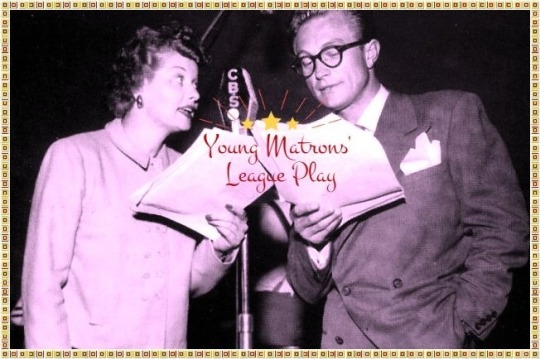
“Young Matron’s League Play” is episode #12 of the radio series MY FAVORITE HUSBAND broadcast on October 9, 1948.
Synopsis ~ George finds out that Liz is in the Young Matrons’ League play and finds a clever way to surprise her!
Note: This episode was aired before the characters names were changed from Cugat to Cooper. It was also before Jell-O came aboard to sponsor the show and before the regular cast featured Bea Benadaret and Gale Gordon as the Atterburys.

“My Favorite Husband” was based on the novels Mr. and Mrs. Cugat, the Record of a Happy Marriage (1940) and Outside Eden (1945) by Isabel Scott Rorick, which had previously been adapted into the film Are Husbands Necessary? (1942). “My Favorite Husband” was first broadcast as a one-time special on July 5, 1948. Lucille Ball and Lee Bowman played the characters of Liz and George Cugat, and a positive response to this broadcast convinced CBS to launch “My Favorite Husband” as a series. Bowman was not available Richard Denning was cast as George. On January 7, 1949, confusion with bandleader Xavier Cugat prompted a name change to Cooper. On this same episode Jell-O became its sponsor. A total of 124 episodes of the program aired from July 23, 1948 through March 31, 1951. After about ten episodes had been written, writers Fox and Davenport departed and three new writers took over – Bob Carroll, Jr., Madelyn Pugh, and head writer/producer Jess Oppenheimer. In March 1949 Gale Gordon took over the existing role of George’s boss, Rudolph Atterbury, and Bea Benaderet was added as his wife, Iris. CBS brought “My Favorite Husband” to television in 1953, starring Joan Caulfield and Barry Nelson as Liz and George Cooper. The television version ran two-and-a-half seasons, from September 1953 through December 1955, running concurrently with “I Love Lucy.” It was produced live at CBS Television City for most of its run, until switching to film for a truncated third season filmed (ironically) at Desilu and recasting Liz Cooper with Vanessa Brown.
MAIN CAST

Lucille Ball (Liz Cugat) was born on August 6, 1911 in Jamestown, New York. She began her screen career in 1933 and was known in Hollywood as ‘Queen of the B’s’ due to her many appearances in ‘B’ movies. “My Favorite Husband” eventually led to the creation of “I Love Lucy,” a television situation comedy in which she co-starred with her real-life husband, Latin bandleader Desi Arnaz. The program was phenomenally successful, allowing the couple to purchase what was once RKO Studios, re-naming it Desilu. When the show ended in 1960 (in an hour-long format known as “The Lucy-Desi Comedy Hour”) so did Lucy and Desi’s marriage. In 1962, hoping to keep Desilu financially solvent, Lucy returned to the sitcom format with “The Lucy Show,” which lasted six seasons. She followed that with a similar sitcom “Here’s Lucy” co-starring with her real-life children, Lucie and Desi Jr., as well as Gale Gordon, who had joined the cast of “The Lucy Show” during season two. Before her death in 1989, Lucy made one more attempt at a sitcom with “Life With Lucy,” also with Gordon.
Richard Denning (George Cugat) was born Louis Albert Heindrich Denninger Jr., in Poughkeepsie, New York. When he was 18 months old, his family moved to Los Angeles. Plans called for him to take over his father’s garment manufacturing business, but he developed an interest in acting. Denning enlisted in the US Navy during World War II. He is best known for his roles in various science fiction and horror films of the 1950s. Although he teamed with Lucille Ball on radio in “My Favorite Husband,” the two never acted together on screen. While “I Love Lucy” was on the air, he was seen on another CBS TV series, “Mr. & Mrs. North.” From 1968 to 1980 he played the Governor on “Hawaii 5-0″, his final role. He died in 1998 at age 84.
Ruth Perrott (Katie, the Maid) was also later seen on “I Love Lucy.” She first played Mrs. Pomerantz, a member of the surprise investigating committee for the Society Matrons League in “Pioneer Women” (ILL S1;E25), as one of the member of the Wednesday Afternoon Fine Arts League in “Lucy and Ethel Buy the Same Dress” (ILL S3;E3), and also played a nurse when “Lucy Goes to the Hospital” (ILL S2;E16). She died in 1996 at the age of 96.
Bob LeMond (Announcer) also served as the announcer for the pilot episode of “I Love Lucy”. When the long-lost pilot was finally discovered in 1990, a few moments of the opening narration were damaged and lost, so LeMond – fifty years later – recreated the narration for the CBS special and subsequent DVD release.
GUEST CAST
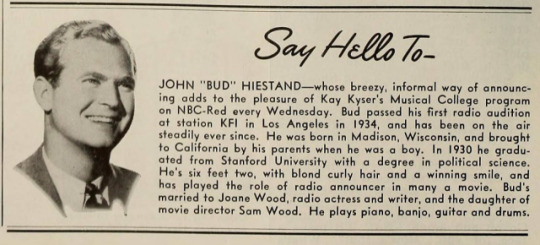
John Hiestand (Cory Cartwright) served as the announcer for the radio show “Let George Do It” from 1946 to 1950. In 1955 he did an episode of “Our Miss Brooks” opposite Gale Gordon.
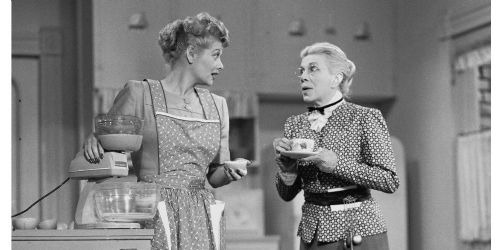
Bea Benadaret (Miss Worthingill, Play Director) was considered the front-runner to be cast as Ethel Mertz but when “I Love Lucy” was ready to start production she was already playing a similar role on TV’s “The George Burns and Gracie Allen Show” so Vivian Vance was cast instead. On “I Love Lucy” she was cast as Lucy Ricarodo’s spinster neighbor, Miss Lewis, in “Lucy Plays Cupid” (ILL S1;E15) in early 1952. Later, she was a success in her own show, “Petticoat Junction” as Shady Rest Hotel proprietress Kate Bradley. She starred in the series until her death in 1968.
In the previous episode, Miss Worthingill was played by Elvia Allman. In 1949, Bea Benadaret will play the regular role of Iris Atterbury, Liz’s best friend.
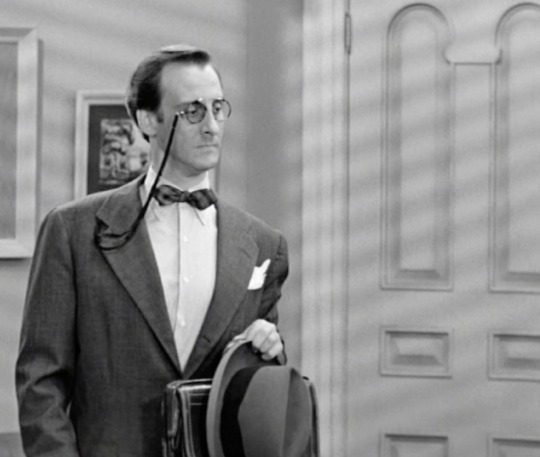
Hans Conried (Adrian LaHoya, Costume Designer) first co-starred with Lucille Ball in The Big Street (1942). He then appeared on “I Love Lucy” as used furniture man Dan Jenkins in “Redecorating” (ILL S2;E8) and later that same season as Percy Livermore in “Lucy Hires an English Tutor” (ILL S2;E13) – both in 1952. The following year he began an association with Disney by voicing Captain Hook in Peter Pan. On “The Lucy Show” he played Professor Gitterman in “Lucy’s Barbershop Quartet” (TLS S1;E19) and in “Lucy Plays Cleopatra” (TLS S2;E1). He was probably best known as Uncle Tonoose on “Make Room for Daddy” starring Danny Thomas, which was filmed on the Desilu lot. He joined Thomas on a season 6 episode of “Here’s Lucy” in 1973. He died in 1982 at age 64.
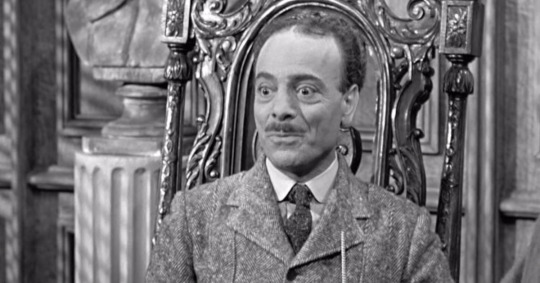
Jay Novello (Cabbie) appeared on “I Love Lucy” as superstitious Mr. Merriweather in “The Seance" (ILL S1;E7), Mario the gondolier in “The Visitor from Italy” (ILL S6;E5), and nervous Mr. Beecher in “The Sublease” (ILL S3;E31). He also appeared on two episodes of “The Lucy Show,” but Novello is probably best remembered for playing Mayor Lugatto on “McHale’s Navy” in 1965.
Beatrice, Miss Worthingill’s assistant, and the Stage Manager are played by uncredited performer.
THE EPISODE
While George is singing in the shower, Liz tells Katie the Maid not to tell him that it is opening night of the play. Liz gets a telephone call from Mrs. Worthingill, director of the play, to remind her that Adrian will be at her home for a costume fitting at 10am sharp! Liz is momentarily taken aback, thinking she is talking about the world famous costume designer Adrian, not Adrian La Hoya.
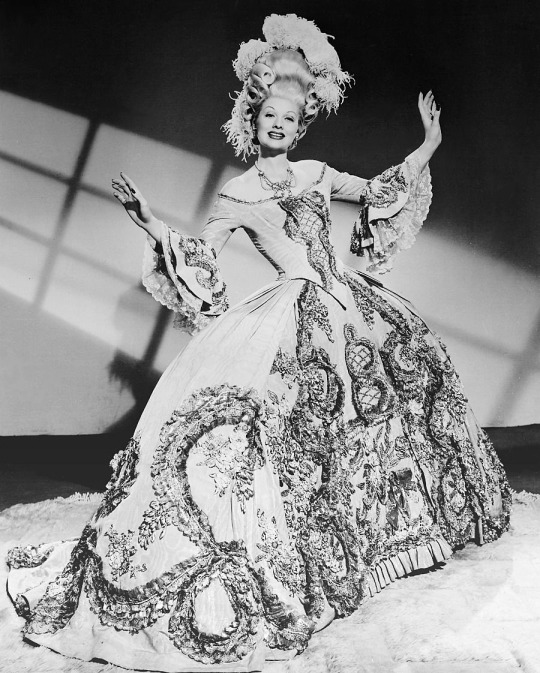
Adrian Adolph Greenburg (1903-1959), widely known simply as Adrian, was an American costume designer whose most famous work was for The Wizard of Oz and hundreds of Metro-Goldwyn-Mayer films such as Du Barry Was A Lady (above) starring Lucille Ball. He was usually credited onscreen with the phrase "Gowns by Adrian".
George comes down to breakfast and says that he has the day off because the bank is closed. Liz needs an excuse to get George out of the house for her fitting. She tells George she’s sick.
LIZ: “Look at my tongue. There’s a coat I.J. Fox would be proud of!”
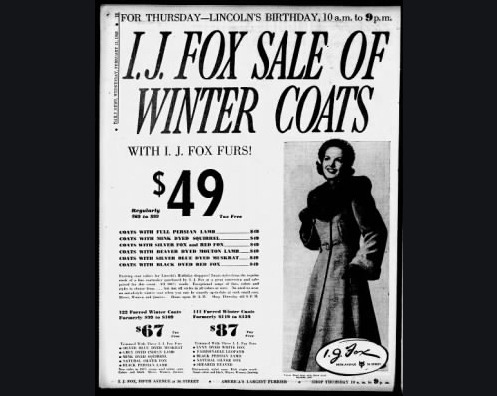
I.J. Fox is one of the nation’s leading furriers. The company is based in Boston, where in 1934 they built a historic art deco store on Washington Street.
George then thinks Liz might be expecting a baby. George decides to go golfing, only if Liz will promise to call the doctor.
Later, Katie answers the doorbell. It is Adrian the costumer (Hans Conried). George comes home unexpectedly and sees Liz wearing a bustle and thinks that she is swollen and assumes Adrian is the doctor.
GEORGE: “What’s wrong with my wife?” ADRIAN: “Nothing. It’s not as bad as it looks. All I have to do is to take few inches off of her hips and tighten the droop in her back. Her peplum is dragging.”
Confusion reigns with the costumer and George talking at cross purposes about Liz’s condition / costume. George leaves the house and learns from Adrian’s waiting cabbie that he’s not a doctor, but a costumer, and that Liz is in the play. George is suspicious of Adrian’s integrity with his wife.
The Cabbie says that his wife was having a weekly Monday night rendezvous with a man at the Laundromat.
GEORGE: “What did you do?” CABBIE: “I bought her a Benidx. Now I don’t know where she goes on Monday nights.”

The Bendix Corporation (1924-1983) licensed their name to a line of electric clothes washing machines. The 1937 Bendix Home Laundry had a glass porthole door, a rotating drum and an electrically driven mechanical timer. The machine was able to auto-fill, wash, rinse and spin-dry. Bendix Home Appliances was later sold to Avco who sold it to Philco. Bendix was mentioned again on “My Favorite Husband” in “Television” (Jun 17, 1949).
George decides to have a talk with Miss Worthingill. George arrives just as an actor has dropped out of the play. Miss Worthingill sees George and gets an idea.
MISS WORTHINGILL: “Come in, Mr. Barrymore! That profile! That noble carriage! That resonant voice! That wavy blonde hair! Those white teeth! Those flaring nostrils! You’re gorgeous. What did you say your name was?” GEORGE: “Cugat. George Cugat.” MISS WORTHINGILL: “Gorgeous George!”
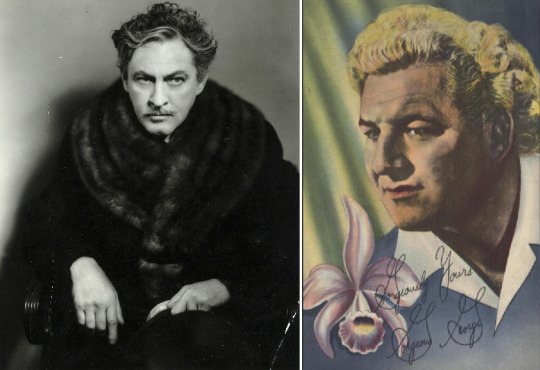
Miss Worthingill is referring to John Barrymore (1882-1942), born John Sidney Blyth, a stage, screen and radio actor of distinction. He was known for his dramatic flare and classic profile. She then calls George ‘Gorgeous George’ (to the delight of the audience). George Raymond Wagner (1915–63) was a wrestler known as Gorgeous George because of his blonde hair. He was mentioned on “I Love Lucy” in “Pioneer Women” (ILL S1;E25) and “Ricky’s Movie Offer” (ILL S4;E6).
George agrees to play the part on the proviso that Miss Worthingill not tell Liz that he is subbing for the ailing actor until they meet on stage.
George goes to Adrian’s costume shop with Cory for a fitting and is given a pair of skimpy tights, which he objects to wearing.
CORY: “George is allergic to tights. He was doing a quick change on the stage in college once. When called for his tights, they thought he said lights!”
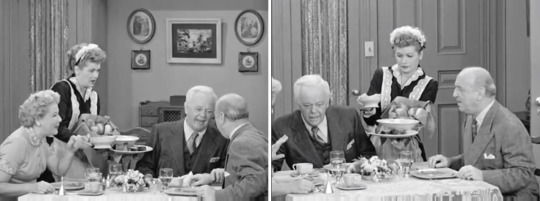
This same gag was told by Fred Mertz to Barney Kurtz in “Mertz and Kurtz” (ILL S4;E2) in 1954.
George tries on the tights and finds them tight. Adrian disagrees, saying:
ADRIAN: “The costumer is always right!”

This clever wordplay takes a moment to earn its laugh. Adrian is punning on the old business motto that “the customer is always right,” a phrase that dates back to 1909, originally coined by London retailer Harry Selfridge to assure customers that they would get good service at his store.
Adrian offers George a suit of armor, but his son has the legs as mufflers on his car. Adrian gives George the tights and a girdle to take home, just in case. When Liz leaves the room, George ducks out to get to the theatre. Liz finds the girdle and tights in George’s suit pocket and suspects marital infidelity!
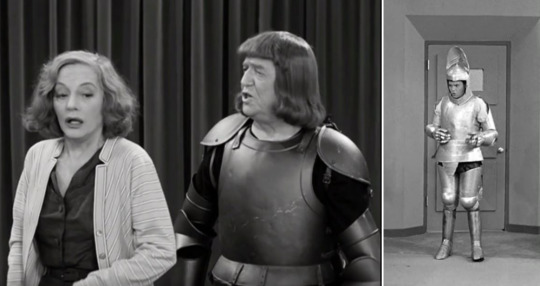
Fred Mertz wore a suit of armor in a play starring Lucy in “The Celebrity Next Door” (LDCH S1;E2) starring Tallulah Bankhead. Ricky tried on a suit of armor during pre-production for Don Juan in “Hollywood at Last!” (ILL S4;E16, right).
Adrian arrives with the armor for George. To keep his identity a secret, George wears his visor down. Liz plays Lady Alice and George is Sir Edward in an unnamed costume drama.
Oops! In the previous episode, the Young Matron’s League play Liz auditioned for was a modern play titled John Loves Mary.
LIZ / LADY ALICE: “Hark! Do I hear a footfall?”
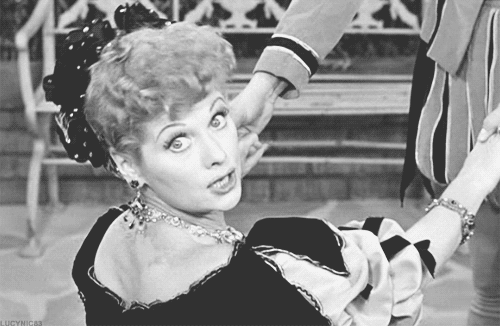
This will also be Lucy Ricardo’s first line of dialogue during her big scene in “Ricky’s Screen Test” (ILL S4;E7) for Don Juan.
Onstage in their scene, Lady Alice lifts the visor and sees it is really George! She instantly starts to have an argument in a stage whisper about the girdle she found in his pocket.
Liz throws a lit cigarette into George’s armor and extinguishes it with a seltzer bottle, ruining Miss Worthingill’s play. Later, Liz is trying to extricate George from the suit, now rusted shut and tells him if he doesn’t tell her the truth about the girdle, he will have to go live at the Smithsonian Institute.

Smithsonian Institution (dubbed ‘the Nation’s attic’) are museums located primarily in Washington DC. The Smithsonian was first mentioned in reference to Ethel’s old washing machine in “Never Do Business with Friends” (ILL S2;E31) and will be mentioned again in reference to the antique Cadillac that Fred buys for the trip to Hollywood in “Getting Ready” (ILL S4;E11). A portrait of Lucille Ball is part of the Smithsonian Portrait Gallery.
Liz and George kiss and make-up and the episode ends!
#My Favorite Husband#Lucille Ball#Richard Denning Ruth Perrott#Bea Benadaret#Smithsonian#I Love Lucy#Selfridge#Adrian#Barrymore#gorgeous george#Bendix#IJ Fox#Jay Novello#Hans Conried#John Hiestand#Bob LeMond
1 note
·
View note
Link
Coronavirus: Health experts join global anti-lockdown movement
Thousands of scientists and health experts have joined a global movement warning of "grave concerns" about Covid-19 lockdown policies.
Nearly 6,000 experts, including dozens from the UK, say the approach is having a devastating impact on physical and mental health as well as society.
They are calling for protection to be focused on the vulnerable, while healthy people get on with their lives.

Signers
Dr. Martin Kulldorff, professor of medicine at Harvard University, a biostatistician, and epidemiologist with expertise in detecting and monitoring of infectious disease outbreaks and vaccine safety evaluations.
Dr. Sunetra Gupta, professor at Oxford University, an epidemiologist with expertise in immunology, vaccine development, and mathematical modeling of infectious diseases.
Dr. Jay Bhattacharya, professor at Stanford University Medical School, a physician, epidemiologist, health economist, and public health policy expert focusing on infectious diseases and vulnerable populations.
Co-signers
Medical and Public Health Scientists and Medical Practitioners
Dr. Sucharit Bhakdi, physician and professor emeritus of medical microbiology, University of Mainz, Germany
Dr. Rajiv Bhatia, physician, epidemiologist and public policy expert at the Veterans Administration, USA
Dr. Stephen Bremner,professor of medical statistics, University of Sussex, England
Dr. Anthony J Brookes, professor of genetics, University of Leicester, England
Dr. Helen Colhoun, ,professor of medical informatics and epidemiology, and public health physician, University of Edinburgh, Scotland
Dr. Angus Dalgleish, oncologist, infectious disease expert and professor, St. George’s Hospital Medical School, University of London, England
Dr. Sylvia Fogel, autism expert and psychiatrist at Massachusetts General Hospital and instructor at Harvard Medical School, USA
Dr. Eitan Friedman, professor of medicine, Tel-Aviv University, Israel
Dr. Uri Gavish, biomedical consultant, Israel
Dr. Motti Gerlic, professor of clinical microbiology and immunology, Tel Aviv University, Israel
Dr. Gabriela Gomes, mathematician studying infectious disease epidemiology, professor, University of Strathclyde, Scotland
Dr. Mike Hulme, professor of human geography, University of Cambridge, England
Dr. Michael Jackson, research fellow, School of Biological Sciences, University of Canterbury, New Zealand
Dr. Annie Janvier, professor of pediatrics and clinical ethics, Université de Montréal and Sainte-Justine University Medical Centre, Canada
Dr. David Katz, physician and president, True Health Initiative, and founder of the Yale University Prevention Research Center, USA
Dr. Andrius Kavaliunas, epidemiologist and assistant professor at Karolinska Institute, Sweden
Dr. Laura Lazzeroni, professor of psychiatry and behavioral sciences and of biomedical data science, Stanford University Medical School, USA
Dr. Michael Levitt, biophysicist and professor of structural biology, Stanford University, USA. Recipient of the 2013 Nobel Prize in Chemistry.
Dr. David Livermore, microbiologist, infectious disease epidemiologist and professor, University of East Anglia, England
Dr. Jonas Ludvigsson, pediatrician, epidemiologist and professor at Karolinska Institute and senior physician at Örebro University Hospital, Sweden
Dr. Paul McKeigue, physician, disease modeler and professor of epidemiology and public health, University of Edinburgh, Scotland
Dr. Cody Meissner, professor of pediatrics, expert on vaccine development, efficacy, and safety. Tufts University School of Medicine, USA
Dr. Ariel Munitz, professor of clinical microbiology and immunology, Tel Aviv University, Israel
Dr. Yaz Gulnur Muradoglu, professor of finance, director of the Behavioural Finance Working Group, Queen Mary University of London, England
Dr. Partha P. Majumder, professor and founder of the National Institute of Biomedical Genomics, Kalyani, India
Dr. Udi Qimron, professor of clinical microbiology and immunology, Tel Aviv University, Israel
Dr. Matthew Ratcliffe, professor of philosophy, specializing in philosophy of mental health, University of York, England
Dr. Mario Recker, malaria researcher and associate professor, University of Exeter, England
Dr. Eyal Shahar, physician, epidemiologist and professor (emeritus) of public health, University of Arizona, USA
Dr. Karol Sikora MA, physician, oncologist, and professor of medicine at the University of Buckingham, England
Dr. Matthew Strauss, critical care physician and assistant professor of medicine, Queen’s University, Canada
Dr. Rodney Sturdivant, infectious disease scientist and associate professor of biostatistics, Baylor University, USA
Dr. Simon Thornley, epidemiologist and biostatistician, University of Auckland, New Zealand
Dr. Ellen Townsend, professor of psychology, head of the Self-Harm Research Group, University of Nottingham, England
Dr. Lisa White, professor of modelling and epidemiology, Oxford University, England
Dr. Simon Wood, biostatistician and professor, University of Edinburgh, Scotland
0 notes
Text
From a ‘desperate’ to ‘respectable’ town; Pleasanton’s mythologized Wild West history | News
Earlier than it was residence to the Alameda County Fairgrounds, Safeway headquarters and greater than 80,000 Bay Space residents, town of Pleasanton was a Gold Rush stopover rife with bandits and cattle, set amongst a grove of sycamore bushes — it was then referred to as Alisal, nicknamed “The Most Determined City within the West.”
Native historians say which may be a bit dramatic.
Pre-contact, the indigenous Ohlone individuals populated the now-called Amador Valley and far of what’s now “the Bay Space.”
The primary Spanish missionaries arrived in 1772, however seemingly dawdled for just a few a long time earlier than establishing Mission San Jose in 1797. For half a century or so, the inhabitants was sparse and life was quaint, even with many rancheros receiving land grants from the Mexican authorities and California’s annexation to america in 1848.
Three main modifications would influence Alisal’s transition into Pleasanton — gold, warfare and railroads.
Ken MacLennan has been the curator of Pleasanton’s Museum on Essential for the final 12 years. The museum is housed within the former City Corridor constructing on Essential Avenue, the place legend and Wikipedia say desperados shot at one another and robbed miners of their every day hauls.
The museum hosts year-round displays of various eras within the metropolis’s historical past from its first inhabitants, the Ohlone individuals, to Spanish missionaries and Anglo settlers, to the impacts of each world wars.
The museum has little on the almost-mythic interval of Alisal’s existence, MacLennan wrote in an e-mail, as a result of “we’ve got by no means had sufficient materials (both artifacts of historic documentation) to assist an in-depth exhibit a few interval that was lower than twenty years and had virtually nonexistent information protection. Many of the lore surrounding the Pleasanton space within the 1850s consists of household tales that lack documentary assist.”
“Lore” is apt.
Few paperwork exist to assist Alisal’s existence, and those who do MacLennan says do not make for a really compelling exhibition.
A Pleasanton Downtown Historic Context Assertion from 2015 barely mentions it as a ranching neighborhood, included into Alameda County in 1853. The Alisal Wikipedia web page is critically missing in citations. Even the native newspapers courting from the 1860s and 1870s, in accordance with MacLennan, referred to the realm as Pleasanton. “Alisal” was used as a substitute title or alluded to because the prior title, now outdated with the inflow of Anglo-Individuals.
Nonetheless, the “Most Determined City within the West” lives on, if solely in popularity.
After the tip of the Mexican-American Struggle (1846-1848), amongst many different reverberating nationwide modifications, america cracked down on landowner residency (quite, lack thereof) on their ranches, and landowners might now not run issues remotely.
Opening up the territory to settlement introduced, amongst others just like the eponymous Robert Livermore, three crucial males to the realm: the Bernal brothers, Augustin and Juan Pablo, and John W. Kottinger, Juan Pablo’s son-in-law, who in 1864 would christen the city as Pleasanton after U.S. Civil Struggle Union Maj. Gen. Alfred Pleasonton. Sure, with two “o’s.” Apparently, there was a typo on the clerk’s workplace.
An early city retailer was constructed the place the Pleasanton Lodge now stands, and there are paved streets named after the Bernals and Kottinger the place there was as soon as valley mud.
Regardless of the gold and new land legal guidelines, not many flocked to Alisal within the 1850s, the land of sycamores, or alders, as is the direct translation. Its proximity to mining websites, lack of political supervision and established horse-driving routes made it an important hideout for bandoleros, desperados and all method of gun-slinging, sheriff-shooting criminals.
That is the place the “determined” popularity comes from, however MacLennan insists there is not a lot to distinguish the Alisal shenanigans than any neighboring city.
“From the 1850s into the early 1870s, the valley was a favourite hideout for outlaws, because it was so thinly populated. One way or the other this later obtained translated to all the “West,” largely by individuals who needed to play up the extra dramatic elements of native historical past. To be honest, Laddsville (later Livermore) had simply as dangerous a popularity as Pleasanton did, and for a similar causes,” MacLennan wrote in an e-mail.
The desperados in query are as mythic because the land they supposedly lived, robbed and killed on.
One of many earliest figures, Joaquin Murrieta, will be the most infamous.
MacLennan has not discovered any proof that Murrieta, a Robin Hood determine of his time, dedicated crimes throughout the quick Pleasanton space, however there are rumors his mom lived close by.
For these not a fan of the Western style, Murrieta impressed the primary novel to be revealed in California, “The Life and Adventures of Joaquin Murieta,” in addition to the character Zorro.
Historical past.com states he was killed by a particular staff of California Rangers on July 25, 1853. His head was severed and preserved in a big jar of whiskey so the rangers might gather the bounty on him. Allegedly, the top went on show at a San Francisco museum till the 1906 earthquake destroyed it.
With the brand new technology of residents within the Gold Rush period got here new bandoleros, and newspapers to contextualize who these males had been.
Murrieta had a nephew, often called Procopio or Purple Dick, who was 12 on the time of his uncle’s dying by the rangers and who supposedly adopted in his crooked footsteps.
There was additionally Juan Soto (no, not the baseball participant), who an 1871 article within the Every day Alta California described as “the worst man of that class who has lived because the well-known Joaquin Murietta,” although it seems to be like there could also be a name-spelling error.
Soto died in a shootout with Alameda County Sheriff Harry Morse in 1871, and by then many of the desperados had been lifeless, jailed or again in Mexico.
MacLennan acknowledges that newspaper reporting on the time was removed from the Society of Skilled Journalists requirements employed as we speak and “you’ll sometimes discover stuff that’s made up.”
Life went on, quietly.
The native inhabitants did not even attain 500 till what on the time was referred to as the Western Pacific Railroad completed its building by means of Pleasanton in 1869. By then, Kottinger had served as native city choose, stepped down to maneuver to San Francisco, delved into actual property and returned to capitalize on the rising white inhabitants.
“In 1862, the railroad was introduced, and the next yr John Kottinger began promoting plots close to the deliberate route,” MacLennan stated. “In 1868-69, the railroad was constructed after a hiatus, and Kottinger obtained collectively together with his neighbor and fellow Bernal in-law Joshua Neal to attract up a city plan, which they filed with the county. The title in town plan is ‘Pleasanton.’ After that, some individuals would possibly use the title “Alisal,” however by 1869, the city is certainly Pleasanton.”
And similar to that, it appears, Alisal was no extra. MacLennan believes the mysticism comes from Pleasanton’s present financial prosperity, partially because the headquarters of a number of companies and upstanding residents. Its “respectability” is what permits the parable to stay on.
“It is secure to return to the ‘shoot ’em up years’ as ‘shoot ’em up years.’ We will deal with it as leisure, not one thing to comb it below the rug, he stated.
Who is aware of, possibly 5 years from now the Museum on Essential will host a coronavirus exhibition documenting how town transitioned by means of a brand new historic interval.
“Curating that exhibit could be a difficult expertise,” MacLennan stated.
Editor’s notice: Story courtesy of the Bay Metropolis Information Basis. To view the article in its authentic on-line presentation from final month, go to localnewsmatters.org.
!function(f,b,e,v,n,t,s) {if(f.fbq)return;n=f.fbq=function(){n.callMethod? n.callMethod.apply(n,arguments):n.queue.push(arguments)}; if(!f._fbq)f._fbq=n;n.push=n;n.loaded=!0;n.version='2.0'; n.queue=[];t=b.createElement(e);t.async=!0; t.src=v;s=b.getElementsByTagName(e)[0]; s.parentNode.insertBefore(t,s)}(window, document,'script', 'https://connect.facebook.net/en_US/fbevents.js'); fbq('init', '1381337412046565'); fbq('track', 'PageView'); Source link
from WordPress https://ift.tt/2Ru8tMZ via IFTTT
0 notes